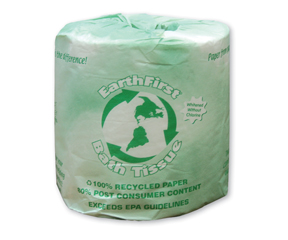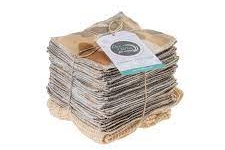Day 19: Toilet Paper!


- Made from 100% recycled paper and 80% post consumer content
- Recycled toilet paper has 1/3 of the environmental impact of non-recycled
- No unnecessary plastic packaging
- No chlorine or other harmful chemicals used in the bleaching process
- Recycled-content toilet paper may be a more sustainable alternative to bidets in water-scarce regions like Colorado where saving water is a top priority
 Even better, try Pee Cloths for Women which are essentially cloth“toilet paper”
Even better, try Pee Cloths for Women which are essentially cloth“toilet paper”
- Made of natural fibers AND deadstock/upcycled fabric
- Save you $100 every year, after the first year
- And, it also feels good. (Charmin’s “softness” can’t touch this!)
- There’s no odor whatsoever and you just wash them with your other intimates on laundry day
- And honestly, I thought this was a little weird at first but now I’m obsessed and even take them on vacation with me!
Challenge 19:
Change to recycled toilet paper. You can find it HERE or buy some Pee Cloths for Women. You won’t regret it.
Day 19: Toilet Paper & Saving Water

According to NRDC, many major toilet paper brands are making their products from trees in the Canadian boreal forest, essentially supporting the logging of a vital environmental resource for a product that is LITERALLY flushed down the toilet.
Logging this forest releases 26 million metric tons of carbon emissions every year, and even toilet paper itself releases remaining carbon into the atmosphere because it has such a short life cycle.
For most products, the majority of its carbon footprint comes from extraction of resources so using recycled content is HUGELY beneficial.
Toilet paper made from new materials is worse because the extraction of wood pulp contributes to deforestation, fossil fuel emissions and water & energy use.
So it’s VITAL to use recycled paper.
We love Earth First Recycled Toilet Paper.
- Made from 100% recycled paper and 80% post consumer content
- Recycled toilet paper has 1/3 of the environmental impact of non-recycled
- No unnecessary plastic packaging
- No chlorine or other harmful chemicals used in the bleaching process
- Recycled-content toilet paper may be a more sustainable alternative to bidets in water-scarce regions like Colorado where saving water is a top priority
Even better, try Pee Cloths for Women which are essentially cloth“toilet paper”
- Made of natural fibers AND deadstock/upcycled fabric
- Save you $100 every year, after the first year
- And, it also feels good. (Charmin’s “softness” can’t touch this!)
- There’s no odor whatsoever and you just wash them with your other intimates on laundry day
- And honestly, I thought this was a little weird at first but now I’m obsessed and even take them on vacation with me!
Simple Ways to Save Water at Home
Water is one of our most precious resources, yet it is often taken for granted. By making small changes in our daily routines, we can significantly reduce our water usage, save money, and help the environment. Here are some simple and effective ways to save water in your household:
1. Fix Leaks Promptly A dripping faucet or a leaking pipe can waste gallons of water each day. Regularly check your plumbing for leaks and repair them immediately to prevent unnecessary water wastage.
2. Install Water-Efficient Fixtures Consider replacing old faucets, showerheads, and toilets with water-efficient models. Low-flow showerheads and dual-flush toilets can dramatically cut down water consumption without sacrificing performance.
3. Turn Off the Tap A simple yet effective habit is turning off the tap while brushing your teeth, washing dishes, or shaving. This small change can save hundreds of gallons of water each month.
4. Use a Dishwasher Wisely If you have a dishwasher, make sure to run it only when it is fully loaded. Dishwashers use less water than handwashing, but running half-full loads wastes both water and energy.
5. Opt for Water-Efficient Laundry Practices Wash only full loads of laundry and choose the appropriate water level setting for each load. Consider upgrading to an energy-efficient washing machine that uses less water per cycle.
6. Collect Rainwater Setting up a rain barrel to collect rainwater can be an excellent way to water your garden or clean outdoor areas without using tap water.
7. Water Your Garden Smartly Water your plants during the early morning or late evening to reduce evaporation. Use a soaker hose or drip irrigation system to direct water straight to the roots where it is needed most.
8. Choose Drought-Resistant Plants Consider planting native or drought-resistant plants that require less watering. These plants thrive in dry conditions and help reduce overall water consumption in landscaping.
9. Reuse Water When Possible Instead of letting water go down the drain, find ways to reuse it. For example, use leftover cooking water to water plants or collect cold water while waiting for the shower to heat up.
10. Be Mindful of Outdoor Water Use Avoid washing cars frequently or use a bucket instead of a hose. Sweep driveways and sidewalks instead of hosing them down to save gallons of water.
By incorporating these simple water-saving habits into your daily routine, you can make a big difference in conserving water and preserving this vital resource for future generations. Start today and take an active role in reducing water waste in your home!
